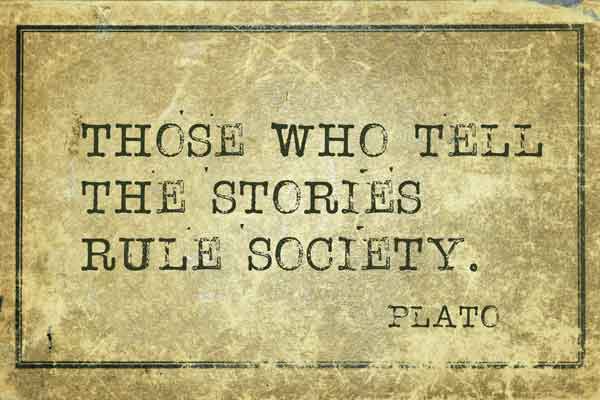Influence, inspire, and engage using story in your school communications
You’re a nice guy (or gal). You’re considerate of others’ time, and you care about your staff and students. Heck, you think your school is doing a great job, but you can’t understand when parents don’t trust your motives, and you’re shocked when you lose a student to another school.
What’s a guy (or gal) to do?
Parents are swamped with information. It comes at them from all angles, so for your message to be considered, you have to stand out from the crowd, and in a good way. Gone are the days of posting basic information on your school website, updating the calendar, and sending home a newsletter once a month to keep everyone informed. Now you have to break through the noise. You have to be interesting.
The blog difference
As a school administrator, you will want to embrace the difference between a news article and a blog article. Writers of news articles typically remove themselves from the article to show their objectivity. Successful blog authors do the exact opposite, using subjectivity, inserting themselves and their humanity into their articles through story.
As a blog author, unlike a journalist who is typically basing his/her article on reporting, information, and facts, you should feel free to describe things from your personal perspective or from the perspective of the storyteller. It is always helpful to validate your opinions when you can with facts and information, but a blog article doesn’t require it and readers today understand that. Go ahead and share a perspective about your school, student needs, and concerns using storytelling to engage, entertain, and influence.
The power of a good story
Our brains love a good story. Heck, we love even a bad story if it fulfills the requisite aspects of a story. Our brains use stories to understand and to learn, to live vicariously with experiences outside of our own while in the safety of our minds. We identify with the protagonist (sometimes the antagonist) and see through their eyes. This is why binge-watching six seasons of that show on Netflix is so compelling and listening to country music makes us cry or laugh.
So, the moral of the story is to write blogs that tell a story. If your reader can identify with the hero, you will be making an immediate connection and they will want to read the whole blog. If they identify with the hero, they will have to find out how it all turned out.

Your blog purpose
In the marketing world, this is called the call to action (CTA) or what it is you want the reader (customer) to do after reading what you’ve written. In the case of a school leader blog, it might be to trust in the strategies you and your staff are using to educate their children. It might be that they will pay for that tax increase because they understand how students benefit from the increased budget capacity. Maybe you are just sharing a story about one student’s success because they put in the work and applied what they learned as evidence of proof that your school and your staff rocks.
Each blog will have a purpose. Identifying it early will help you keep your blog article on topic as well as identify stories that will align with your blog’s purpose.
Your blog audience
Don’t be afraid to show your humanity when you write a blog. This isn’t a thesis or a governing board report; it is a blog written to humans by a human. As a school administrator, you have lots of stories at your disposal, many of which will be easy for your readers to identify with. Your readers will likely be parents who have school-age children. That makes your job much easier, right?
Keep an image of who you are writing for in your mind as you write (in the marketing world, this is called the “buyer persona.”) If you remember you are writing to that one person, the process will be much easier and more engaging for your readers. Keeping your blog audience in mind is critical to the blog’s success.
Your blog opening
Set the scene with a gripping first line. Sharing the human experience, describe what the reader wants (their problem or challenge) and how they feel when they don’t get it. They will relate and want to read the rest of the blog where you paint the picture of the solution (while giving them practical advice that will solve their problem). The sooner you can get to the story, the more likely your readers are to keep reading.

How to use stories in your blog posts
There are many ways to effectively use stories in your blog articles. Here are a few:
Tip #1: Include the essentials of a good story
Most writers will tell you there are three elements of a story. They are:
- a sympathetic character (someone our readers can identify or empathize with);
- a conflict (what is the problem they face); and
- resolution/transformation (how is the situation improved or the character changed for the better).
We tend to instinctively include these elements in stories, but if you can learn to recognize them and include them, your stories will be more compelling.
Tip #2: Use Examples
Use stories from your experiences at school/work and your personal life to make your blog more entertaining. This will enliven your post and help readers see humanity and relate to you, your school, and your article. People identify with one another, so make your story more powerful by adding a story that will help your reader relate to the story experience. Don’t be afraid to use examples from your personal life!
Example stories can introduce a problem from a specific parent or student’s perspective. A common example might be a time a teacher gave encouragement and resources to a student who felt overwhelmed by a challenge and wanted to give up, helping the student overcome the situation and find success. Example stories are great at helping us put ourselves in the shoes of someone who has overcome challenges or faced similar issues. They give us hope and insight and can provide proof of how our school or staff solves problems and creates successes for students (and parents).
Tip #3: Align with your blog post topic
This might seem an obvious tip, but your story should align with your post’s message. Because each story has a meaning, just make sure that what you want people to glean from the story fits with your blog idea.
Tip #4: Conduct interviews
Interviews are a rich source of story gathering. So are testimonials, which you know you should also be gathering for your website. Use these as stories in your blog because real experiences can reinforce your message, build trust, and provide transparency. Interviews are also an excellent way to collect stories—particularly success stories.
Tip #5: Gather personal anecdotes
You have had many experiences as a student/teacher/parent that impact your leadership/teacher/learning today. A personal, interesting, or humorous story about a real person (you or someone else) carries a lot of weight in our memories and in how we relate to the message or example in the story. Gather anecdotes wherever you find them. These will be brief, about an individual person or incident, and will have a point. Many bloggers and writers even collect and record memorable anecdotes for later use. You’ll be surprised by what a great resource this will be when you need a few stories to invigorate your blog articles.
Blog story types
For some ideas of the types of stories you might want to gather, consider the following:
- Stories of successful or beloved staff members over the years
- Stories describing the school’s founding or interesting history
- Stories that reflect your school’s values in action
- Stories of students, staff, or alumni who have overcome barriers
- Success stories about students who gain confidence, develop a love of learning, learn something new, overcome challenges or fears, etc.
- An opinion piece that shares the story that led you to form your opinion (about a topic of importance to parents or the community now)
- Personal stories that describe your own experiences (These make strong connections with your readers—especially when you transfer your emotions onto the page.)
For help with story prompts to gather these stories, check out our blog article on Telling Your School’s Stories.

Ask yourself the right question
Finally, or maybe before you even begin, ask yourself, “As a result of hearing my story or reading my blog article, what should people think, feel, or do?”
Effective communication. That really is the purpose of a blog article, a story, a presentation, a social media post, or a school website post, right?
Whenever we attempt to communicate with someone, we offer them something in exchange for their time, so we must be clear about what we want them to take away from our efforts. Answering this question will help ensure your blog and the stories within your blog are focused on the audience’s needs and, in the process, they will vastly improve your communication efforts.
Posted by Bonnie Leedy, CEO, School Webmasters, LLC.








